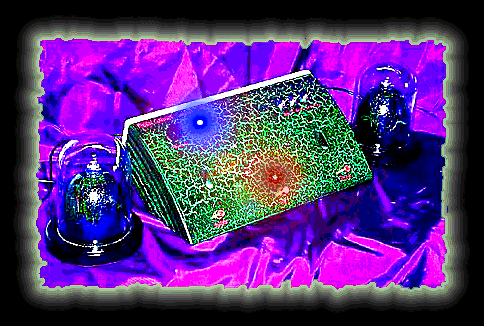Photon Clarinets are played without touching. Waving a hand over the
right-hand sensor steps the pitch through arbitrary rising or falling
notes, as in an alien keyboard; a hand over the left-hand sensor smoothly
sweeps the notes, as in a theremin.
More from Reed's EMI article on the Photon Clarinet:
"Part of the (elementary) school's yearly program involved bringing
an unusual music act to the stage. All sorts of instruments were demonstrated,
many chosen to mystify young school children. The musical saw, singing
water glasses, thunder sheets... but to watch as the musician waved
hands around a silvery metal loop stemming from the top of a mysterious
box, and to hear in response what sounded like an operatic woman's voice
singing from within hit me in a way that left me somewhat stunned for
the rest of the week.
"While the playing technique of the Theremin is certainly unusual, its
main voice is simply that of an oscillator caused to smoothly glide
across its range due to interference imposed by the musician's body.
Using light, one of the two sensors of my modern Photon Clarinet does
the same: as the musician's hand shadow varies upon this sensor the
pitch of the instrument falls from very high to super low.
"It is the second sensor that is responsible for the more unexpected
music that the Photon Clarinet creates...
"When a hand is waved over this second sensor, the pitch steps rather
than sweeps between notes, as if the player is riffing upon a fretted
or keyed instrument. Each sensor will allow the pitch to travel its
entire range, from high to so low that only clicking pulses are audible.
In use, the player generally modulates the light falling upon the 'sweep'
sensor with the left hand, and the 'step' sensor with the right. What
this does, in effect, is to rather strangely replicate the process of
playing a keyboard... left hand on the pitch-bend wheel and right hand
on the keys.
"Today's Photon Clarinet contains, along with a line-output and the
two sensors mounted in various bases, LED's for both power and envelope,
afocus switch which compresses and filter-sweeps the signal (creating
a second voice), an initialize control which steps through a series
of pitches and establishes the free note that the unmodulated instrument
will return to, plus an internal monitor speaker with cut-out switch.
"Many different effects can be achieved by playing the instrument as
described before. In addition to simply riffing with the right hand
and modulating with left, careful movements over the step cell will
cause filter and loudness shifts over the shadow-span of a single note,
before the light threshold necessary to change to the next note is reached.
This allows the right hand over the step cell to induce tremolo (volume
fluctuation) as the left hand over the sweep cell controls vibrato (pitch
fluctuation).
"While the stepped notes of the Photon Clarinet scales don't follow
intervals we are familiar with, a practiced musician can bend the pitches
thereby persuading enough conformity from the device to allow accompaniment
of traditional musics. Personally, I see no more reason to demand this
of an instrument than I would a songbird. The abstract calls of nature,
blind to the logic of musical semantics, are emotionally powerful, descriptive
sound-forms, and I feel that even instruments entirely restricted to
such voices stand upon equal ground with the rest."
Built into a curved speaker case, the Curved Photon Clarinet with remote
glass domed sensors is a very solid example of the instrument. The speaker
cases themselves were meant to be add-ons to the sides of computer monitors,
are well built and sound very good driven by the circuit's electronics.
The front of the instrument is supported by two legs beneath the oblong
speaker grille. The back of the instrument (seen above) supplies controls
including a range dial (for setting the pitch of the "free" note that
the unmodulated instrument returns to), a focus switch (phases the ends
of the note envelopes), speaker on/off switch, power switch with blue
LED pilot lamp, pulsing red envelope LED and gold-plated RCA (phono)
line output. Two more gold-plated RCAs are located on the case back
for the remote sensors.
This Photon Clarinet is one of several models that include remote sensors
beneath glass dust covers. Each remote sensor, one for sweeping the
pitch ant the other for stepping the pitch via hand shadow, contains
a photo resistor beneath a vintage pilot lens. Sensor bodies are wooden
with felt base cloth, milled and piped in the anti-theory workshop for
sturdy joinery. Sensors are colored in several stages to match the instrument's
case.
The case itself is finished in crackled fluorescent colors and dusted
with iridescent powder under a final gloss. Control titles are hand
inked.




.jpg)
